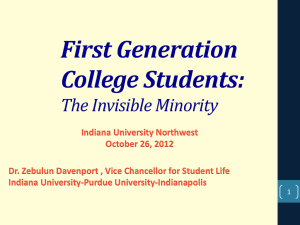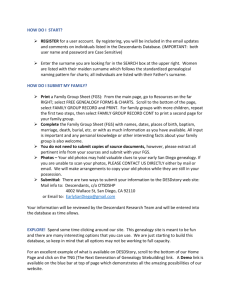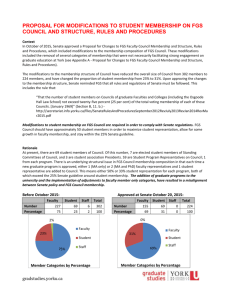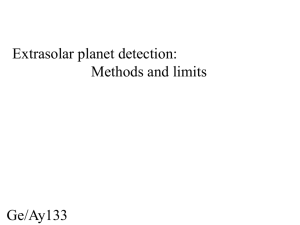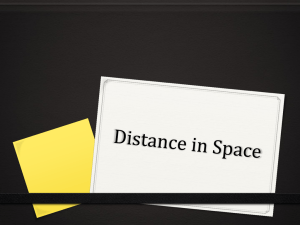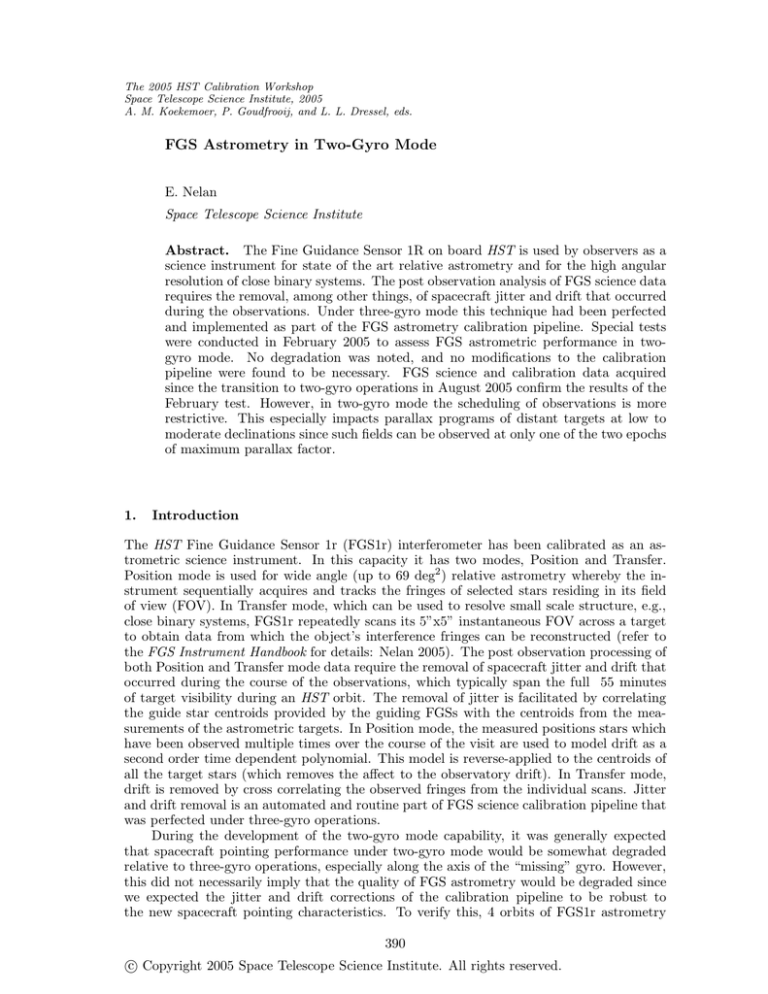
The 2005 HST Calibration Workshop
Space Telescope Science Institute, 2005
A. M. Koekemoer, P. Goudfrooij, and L. L. Dressel, eds.
FGS Astrometry in Two-Gyro Mode
E. Nelan
Space Telescope Science Institute
Abstract. The Fine Guidance Sensor 1R on board HST is used by observers as a
science instrument for state of the art relative astrometry and for the high angular
resolution of close binary systems. The post observation analysis of FGS science data
requires the removal, among other things, of spacecraft jitter and drift that occurred
during the observations. Under three-gyro mode this technique had been perfected
and implemented as part of the FGS astrometry calibration pipeline. Special tests
were conducted in February 2005 to assess FGS astrometric performance in twogyro mode. No degradation was noted, and no modifications to the calibration
pipeline were found to be necessary. FGS science and calibration data acquired
since the transition to two-gyro operations in August 2005 confirm the results of the
February test. However, in two-gyro mode the scheduling of observations is more
restrictive. This especially impacts parallax programs of distant targets at low to
moderate declinations since such fields can be observed at only one of the two epochs
of maximum parallax factor.
1.
Introduction
The HST Fine Guidance Sensor 1r (FGS1r) interferometer has been calibrated as an astrometric science instrument. In this capacity it has two modes, Position and Transfer.
Position mode is used for wide angle (up to 69 deg2 ) relative astrometry whereby the instrument sequentially acquires and tracks the fringes of selected stars residing in its field
of view (FOV). In Transfer mode, which can be used to resolve small scale structure, e.g.,
close binary systems, FGS1r repeatedly scans its 5”x5” instantaneous FOV across a target
to obtain data from which the object’s interference fringes can be reconstructed (refer to
the FGS Instrument Handbook for details: Nelan 2005). The post observation processing of
both Position and Transfer mode data require the removal of spacecraft jitter and drift that
occurred during the course of the observations, which typically span the full 55 minutes
of target visibility during an HST orbit. The removal of jitter is facilitated by correlating
the guide star centroids provided by the guiding FGSs with the centroids from the measurements of the astrometric targets. In Position mode, the measured positions stars which
have been observed multiple times over the course of the visit are used to model drift as a
second order time dependent polynomial. This model is reverse-applied to the centroids of
all the target stars (which removes the affect to the observatory drift). In Transfer mode,
drift is removed by cross correlating the observed fringes from the individual scans. Jitter
and drift removal is an automated and routine part of FGS science calibration pipeline that
was perfected under three-gyro operations.
During the development of the two-gyro mode capability, it was generally expected
that spacecraft pointing performance under two-gyro mode would be somewhat degraded
relative to three-gyro operations, especially along the axis of the “missing” gyro. However,
this did not necessarily imply that the quality of FGS astrometry would be degraded since
we expected the jitter and drift corrections of the calibration pipeline to be robust to
the new spacecraft pointing characteristics. To verify this, 4 orbits of FGS1r astrometry
390
c Copyright 2005 Space Telescope Science Institute. All rights reserved.
FGS Astrometry in Two-Gyro Mode
391
Figure 1: The FGS interference fringe. Vertical direction is fringe amplitude, horizontal
direction is angle on the sky. Note the indicated angular scale. During a Position mode
observation or while tracking a guide star, the FGS tracks the feature of the fringe at the
cross hairs.
were included as part of the February 2005 on-orbit two-gyro mode test (Nelan 2005).
Since the transition in late August 2005 to full time two-gryo operations, additional FGS
astrometry data from both the GO and calibration programs have become available. The
recent data confirm the findings of the February test and shows that the calibration pipeline
is indeed well suited for processing two-gyro mode astrometry data. Interestingly, we find
that contrary to earlier expectations, there is no significant degradation to the quality of
the HST pointing control system performance relative to three-gyro operations. We expand
upon this in the next section.
2.
FGS Astrometry Data in Two-Gyro Mode
In Position mode the FGS tracks the so called “zero-point” crossing of the star’s interference
fringe (Figure 1). As the position of the star in the FGS detector frame changes, the star
selector servos reposition the instrument’s optical axis to keep the “cross hair” centered
on the fringe. From these adjustments, which occur at 40 Hz (for bright stars), one can
track the 2-dimensional (x,y) position of the star in the detector during the course of the
observation (the FGS generates fringes in two orthogonal directions).
The guiding FGSs track their respective guide stars in an identical fashion, an important difference being that the guide star centroids are used by the spacecraft pointing
control system to fine point and stabilize HST. By converting the local (x,y) coordinates
of the astrometry target and guide star centroids in the respective FGSs into the vehicle
(V2,V3) reference frame, one can compare how well changes in the centroids from the 3
FGSs correlate. A close correlation indicates that each FGS observed changes corresponding to motion of the telescope, while poor correlation indicates that the noise equivalent
angle of one or more of the centroids is larger than the pointing jitter.
392
Nelan
Figure 2: The correlation of V2 (left) and V3 (right) jitter witnessed by the 3 FGSs in a
two-gyro mode observation.
Figure 3: The correlation of V2 (left) and V3 (right) jitter witnessed by the 3 FGSs in a
three-gyro mode observation.
FGS Astrometry in Two-Gyro Mode
393
Figure 4: The change in the V2 centroid of the dominant guide star during the course of
an astrometry visit in two-gyro operations. The circles mark the temporal midpoints of
the individual astrometry exposures. At each point, the guide star centroids are computed
over the time of the astrometry exposures. The stability of the guide star centroids in
two-gyro mode is essentially that same as in three-gyro mode. This “jitter” is removed by
the calibration pipeline.
2.1.
Jitter
Figures 2 & 3 show the 40 Hz correlation of an astrometry target star and the two guide
star centroids in V2 and V3 for observations under two-gyro and three-gyro operations,
respectively. In these two cases all three stars are fairly bright and the data from the three
FGSs correlate quiet well. It is note worthy to point out that the amplitude of the jitter
is similar in both cases. The apparent periodicity of the jitter is due a vibrational mode
of the high gain antennae and is present in both two and three gyro operations. The good
correlation across the three FGSs indicates that the guidance data can be used to eliminate
jitter in the astrometry data.
However, the calibration pipeline does not use the 40 Hz guidance data for jitter removal. Rather, the pipeline uses the guide star centroids that are computed (via a trimmed
mean or a median filter) over the duration of an individual astrometry observation, which is
typically 20 to 30 seconds. For illustration, Figure 4 shows the change in the V2 location of
a guide star’s position in the dominant guider (FGS2 in this case, corrected for differential
velocity aberration) over the course of an orbit while FGS1r executed astrometry observations. The small circles mark the mid-points of the astrometry observations. The data
plotted here are from two-gyro operations. This is consistent with three-gyro performance.
2.2.
Drift
The drift of the HST focal plane across the sky during the course of a visit is a familiar
phenomenon that is generally attributed to “breathing” of the telescope, i.e., the change
in focus due to displacement of the secondary mirror in response to thermal cycling. If
394
Nelan
Figure 5: Schedulability of a target field as a function of the fields parallax factor, or day
of year. Observation at epochs of ”blue” parallax factors, or days, can be scheduled in
two-gyro mode, the “red” days cannot. for clarity, every fifth day is plotted. The choice of
the HST UDF is for illustration only.
not accounted for, this effect would impress an error of about 5 mas on FGS astrometric
measurements. As discussed in the introduction, the effect is easily removed provided several
selected stars are observed multiple times over the course the HST visit. The signature
of this drift is, as expected, unchanged in two-gyro operations compared to three-gyro
operations.
2.3.
Transfer Mode
As discussed above, under two-gyro operations the spacecraft jitter and drift characteristics
are not appreciably different than in three-gyro operations. Therefore, no change in the
quality of data acquired by FGS1r in Transfer mode is expected. Indeed, the results of the
February test demonstrated this. GO and calibration data obtained since the commencement of two-gyro operations in August 2005 confirm this conclusion.
3.
Scheduling
Some astrometric programs may be impacted due to the more stringent scheduling constraints in two-gyro operations. In particular, the fixed head star trackers (FHTS) must not
be occulted by the Earth since they are needed to coarse guide the telescope as the guiders
acquire their respective guide stars (the FHSTs view the sky in a direction ≈perpendicular
to the V1 axis). This eliminates access to one of the two epochs of maximum parallax factor
for a given target field, an effect that has greater impact with decreasing declination. For
illustration, Figure 5 shows the schedulability of observations in the HST UDF as a function
of the field’s parallax factors in RA and Declination, which each symbol corresponding to a
particular day of year (every fifth day was plotted for readability). For this particular field,
FGS Astrometry in Two-Gyro Mode
395
the optimal times to observe for a parallax program would be at the extreme ends of the
ellipse. However, in two-gyro mode observations can only be scheduled on the “blue” days.
The impact of these scheduling constraints will increase the error of a parallax measurement, but not generally by the amount which is proportional to the reduction in difference
of the parallax factors at the epochs of the observations. Other sources of error enter as
well, such as residuals of the geometric distortion calibration, and the conversion from relative to absolute parallax. Nonetheless, for targets near the distance limit (d >≈ 400 pc)
of accurate FGS parallaxes, the scheduling constraints become important for moderate to
low declination fields.
4.
Summary
FGS astrometry in two-gyro mode yields data of the same quality as that obtained in
three-gyro mode. No modifications to the calibration pipeline or the calibration program
are found to be necessary. The new scheduling restrictions can lead to a reduction in the
accuracy of parallax measurements for distant objects at moderate to low declinations.
References
Nelan, E., et al. 2004, Fine Guidance Sensor Instrument Handbook, version 14.0
(Baltimore: STScI)
Nelan, E. 2005, FGS Astrometry in the Feb 2005 On-orbit Two-Gyro Mode Test
www.stsci.edu/hst/HST overview/TwoGyroMode/documents/FGS.pdf



